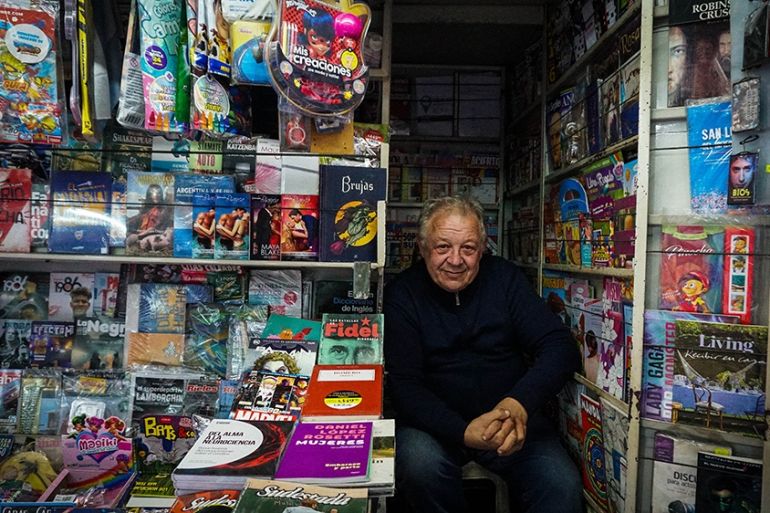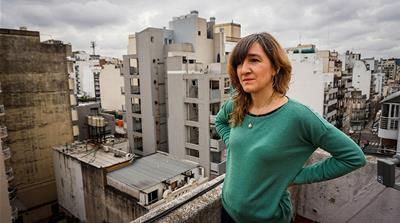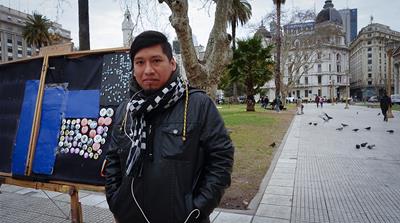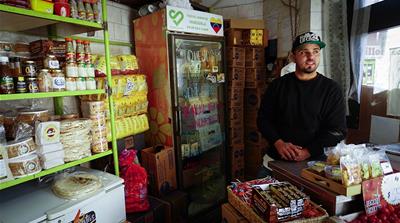The US dollar is sewn into Argentina’s economy and its culture
Argentina’s official currency is the peso but it’s the greenback that defines the country’s shifting economic landscape.

Buenos Aires, Argentina – Lorenza Romero’s stationary shop on Monroe Avenue is painted red on the outside, with a wide window and a glass-covered counter filled with banknotes from around the world. It’s her son’s collection, and all but one currency is out of circulation – the United States dollar bill.
“That’s the one that drives people crazy here,” she says. “Their own currency doesn’t count for them.”
Keep reading
list of 4 itemsAs US inflation ticks back up, it could impact the presidential election
Will the US unemployment rate continue at historic lows?
The UK’s new minimum wage ‘badly needed’ but many calling for more
The 72-year-old grandmother’s observation exposes what is a raw nerve for many Argentines. The country’s official, sovereign currency is the peso – people earn in it, and they spend with it – but it’s the US dollar that defines value here.
The peso-dollar exchange rate is quoted daily by the media, alongside weather and traffic reports. Ask anyone, in any sector and any strata of society in Argentina, and they can probably tell you how many pesos it takes to buy a dollar on any given day (around 56 at last count).
The greenback’s overriding influence has become even more commanding this year, thanks to a grinding economic crisis that has seen the peso’s value plummet in the lead-up to the presidential election next month.

‘Our brains are completely dollarised’
The dollar has a formal role in the economy. It’s the currency in which real estate transactions are made, some debts are carried, and savings, if possible, are accumulated.
But it’s also sewn into the culture, as the punchline of jokes, the theme of memes, the silent protagonist in films. And it’s become a shorthand for a shifting economic landscape, from what to expect in the grocery store aisle, to who will become president.
“Our brains are completely dollarised,” Alejandra Covello, president of Covello Propiedades, a Buenos Aires-based real estate developer, tells Al Jazeera.
The push and pull of this bi-monetary system revved into high gear in the weeks following the August 11 presidential primaries, which served as a litmus test for the general elections on October 27.
President Mauricio Macri, whose neoliberal agenda had rolled back subsidies and opened up the market, was thrashed at the polls, losing to the main opposition ticket of Alberto Fernandez and former president Cristina Fernandez de Kirchner by a whopping 15 points.
The political rout triggered an economic one, with the peso losing more than 25 percent of its value in the days that followed the primaries. Screaming headlines tracked the “flight” of the US currency out of the country, as if it was a person fleeing for his or her life.
‘The dollar is in the DNA of Argentines’
The title of a new book by Argentine sociologists Mariana Luzzi and Ariel Wilkis encapsulates how large and how long the dollar has loomed over Argentina: The Dollar: History of an Argentine currency (1930–2019).
The book highlights a turning point at the end of 1958, following the coup that ousted Juan Domingo Peron. Then-President Arturo Frondizi implemented a so-called “Stabilisation Plan” that liberated the market and included Argentina’s first agreement with the International Monetary Fund (IMF). The plan sent the peso into free fall. The government announced a holiday for the Argentine exchange market, meaning no currency could be exchanged for 12 days. When operations resumed in January 1959, the masses rushed to the exchange houses on San Martin Street in Buenos Aires, clamouring for information on the value of the currency that would bring them fortune or famine.
“This is a milestone for us because it signals the moment in which the dollar became this object of attention,” Mariana Luzzi tells Al Jazeera.

News about the dollar went from technical and staid to vital and vibrant, with photos and daily stories that created a new way of narrating the economy in Argentina.
The dollar became the lens through which people learned to evaluate what was happening around them, says Luzzi. Analogies like “the price of beef loin is in the clouds – it costs as much as the dollar” helped cement this understanding, Luzzi adds, so that when the economy got worse, and hyperinflation took hold in the 1970s, families turned to the greenback to shield their savings.
That pattern persists to this day.
When Macri announced at the end of August that the country needed more time to pay off its debts, and then imposed capital controls to help calm the markets, there was a spike in the number of people who went to buy and withdraw their dollars from the banks, fearing a repeat of the 2001 “corralito” in which US funds were frozen, and for many, lost.
Luzzi says this idea of the dollar as “refuge” is one that has been cultivated over the years. “It’s like when people say, well, the dollar is in the DNA of Argentines,” she says. “It’s a phrase that gets repeated.”
‘The dollar is like poison’
What is clear is that the story of the dollar in Argentina is intertwined with that of inflation. Its value affects the cost of imported goods, but it also affects domestically made products that use raw materials Argentina sells on the international market, because they are priced in dollars. So a carton of milk might shoot up in price because local farmers feed cows local grain that they buy in dollars.
The power of speculation is also at play. Economist Gabriel Rubinstein, of the Buenos Aires firm Gabriel Rubinstein & Associados, says the fluctuations in the dollar technically only account for a fraction of the price increase in pesos. The rest, he says, is speculative – producers hiking prices just in case.
“It’s not just a question of trying to gain advantage; it’s more an instinct of preservation,” he tells Al Jazeera, adding that it produces a chain reaction that hurts consumers in the end.

“The daily gymnastics that we perform in Argentina is not the same as in a country that has low inflation,” he adds.
It all translates into one thing for Daniel Estudillo, the owner of a newspaper stand on Avenida de Mayo, in the heart of Buenos Aires.
“The dollar is like poison,” the 65-year-old tells Al Jazeera. “Because the dollar goes up, and all the products go up.”
Romero, the shop owner on Monroe Avenue, sees the same thing. As the dollar has climbed, and people’s purchasing power has dwindled, she’s had to drain her savings to keep her business afloat.
“I think that if you’re here, you have to use this country’s currency,” she says, leaning over the counter with the dollar bill. “Everything is peso. Workers earn in pesos. They don’t have enough to survive. How are they going to buy dollars?”
The idea of making the dollar Argentina’s official currency – as other countries in Latin America have done – is floated periodically, most recently this month in The Wall Street Journal.
In the 1990s, the peso was pegged to the dollar by the government of then-President Carlos Menem in an attempt to stifle inflation. It was far from painless. The dollar peg battered exports, forcing the government to take on more debt to keep it afloat as an economic crisis worsened.

In 2001, fearing a run on the banks, the government of former President Fernando de la Rua imposed the notorious “corralito”. The outrage that resulted forced de la Rua’s resignation.
The dollar took a central role again in 2011, when current vice-presidential candidate and former President Cristina Fernandez de Kirchner enacted strict controls on the purchase of greenbacks. The controls weren’t lifted until Macri took office in 2015.
“We can’t look at it as a [bi-monetary] system that one chooses. We have to look at it as a reality that occurs,” said Rubinstein, a former representative of the Central Bank of Argentina.
For Carlos Eduardo Gonzalez, 28 and a recent migrant from Venezuela, saving in dollars is common sense. He’s been doing it since 2015, first as a hedge against his own country’s plummeting currency, and now as the owner of a shop selling Venezuelan goods in the Buenos Aires neighbourhood of Belgrano.
“You can tell that people don’t have faith in the peso now,” he tells Al Jazeera.
Thirty-year-old father Simone Tejada, who sells souvenir pins in front of the Casa Rosada presidential palace, doesn’t consider one currency to be more important than the other. But the value of both weigh on him constantly, as he wonders how he will afford to buy milk and bread for his young daughter.
“The dollar is the everyday for us, because it affects us every minute, in everything,” he says. “If I could save in dollars, I would.”